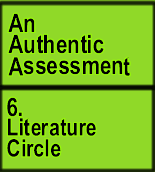Literature Circle
This semester was my first time to participate in a literature circle "mano a mano." Our group was the secondary / adult readers cohort consisting of two females and two males. One female was a native Chinese speaker; I, the other, was a non-traditional doctoral candidate. Both males were in the MAT (Masters of Arts in Teaching) program, so we were a diverse group. We chose to read Leslie Marmo Silkeís Ceremony and Chinua Acebeís Things Fall Apart. Fortunately for me, both these books have been on my reading list for several years. Our rationale included representation of culture, a writer from outside the United States, and novels that appear on high school and college reading lists.
Silkeís book has been a topic of discussion in another arena of my life. As a Tai Chi practitioner, I have been exposed to aspects of Native American culture that relate to the Tao because our Sifuís (teacherís) grandmother was Native American (Cherokee), and he had been raised with her traditions. He often pointed out spiritual traditions of Native American culture that paralleled the underlying philosophy of Tai Chi, such as respect for nature and its influence on our whole being, high regard for ancestors and traditions, and the idea of being present in the moment.
Several of my former African students had recommended Achebeís book, and I had often seen it in the bookstore as required reading for a gamut of classes. It begged to be read. Now I appreciate why. Acebe compellingly describes tribal life in Nigeria from the point of view of a successful leader who falls out of favor and has to leave the tribe, then returns to find irrevocable changes in his village. This was my first read of a truly African way of life and its demise with the influx of Europeans and Christianity.
Both novels were emotionally disturbing as they documented the difficulties of an individualís coping with traumatic events arising from the imposition of a dominant or invading culture. The struggles of these individuals bring to mind Sleeterís (1992) article on how we teach multiculturalism in our classrooms and how important it is for instructors to educate themselves about diversity. When I consider the testimonies of new immigrants from our classmatesí cultural explorations, I stand in awe of the fortitude and perseverance of those individuals, many of whom are students in Arkansas public schools, and how little their peers and classmates know of their efforts to survive and adapt to a challenging and "foreign" environment. This knowledge strengthens my conviction to become more aware and ethnically developed (Young, 1995).
We received helpful handouts to help us organize literature circles in our own classes. I had the opportunity to suggest using this technique in Novice Teacherís ACTAAP class. He agreed, so I take this opportunity to include part of the reflection regarding the implementation of this technique as evidence of theory into practice.
Reflection Three
I have chosen to respond to the article on creating a literature circle as it relates to ELLs (English Language Learners). I will relate a personal anecdote to support the idea that a literature circle (somewhat modified) can be implemented in a classroom of diverse learners.
Former students and current practitioners often ask me what to do with ELL students in their secondary content classes. Just recently, a new teacher (Novice Teacher, whose personna is referenced frequently in this e-folio) asked me what to do with an ELL student, a native speaker of Spanish, who was in a class designed primarily to remediate students who had failed the state Benchmark exams. The class was called "ACTAAP remedial." Frankly, I had never heard of such an acronym, as my teaching experience is post secondary. (If you're wondering what the acronym means, good luck!) Second, the novice teacher's student was the only ELL student in a group of 12. However, she was highly motivated to learn English.
Drawing on my experience for beginning English learners in an IEP (Intensive English Program), I suggested that the instructor use Sandra Cisnerosí book, House on Mango Street. Cisneros' novel satisfied several learning requirements: it related to the student's cultural background; the novel incorporated Spanish words and phrases; and, in a practical sense, I already had the novel and the workbook!
When the instructor prepared the first lesson, the outcome was astounding and rewarding. The student was so motivated that several other students also wanted to read the book. Suddenly a piece of literature had crossed cultures and abilities. A literature circle arose! The instructor used the workbook for the five students and purchased readers for each student in the circle. They learned vocabulary and response writing as well as reading strategies, discussion techniques, and expanding their social awareness. Not only did this relate to literary circles, it also supported several goals of cooperative learning: 1) to improve communication among students, 2) to produce quality learning, and 3) to increase academic achievement (Kellough, 2003, p. 300). In addition, the students constructed their learning goal for the class.
The most rewarding aspect of this anecdote is that the students showed desire and passion for learning, even though the topic was about another culture. The students are from an isolated town in rural, west-central Arkansas, where diversity is prevalent and where resources are extremely limited. It also shows that teachers have to be willing, open, and attuned to their studentsí needs.
*This is the next step toward THE One World Language.
Step Six: *Your lesson plan on remote control.
Planet Gnosis is ruled by Freddie A. Bowles, a professional educator and fellow at the Department of Curriculum and Instruction, the University of Arkansas at Fayetteville. An independent entity in the CornDancer consortium of planets, Planet Gnosis is dedicated to the exploration of education and teaching. CornDancer is a developmental website for the mind and spirit maintained by webmistress Freddie A. Bowles of the Planet Earth. Submissions are invited.
|





